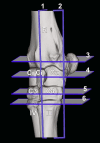Magnetic resonance imaging of the dromedary camel carpus
- PMID: 39242548
- PMCID: PMC11378426
- DOI: 10.1186/s12917-024-04184-8
Magnetic resonance imaging of the dromedary camel carpus
Abstract
Background: The dromedary camel (Camelus dromedarius) carpal joint presents multiple joints and constitutes several bones and soft tissues. Radiography and/or ultrasonography of the carpus are challenging due to structural superimposition. High-field magnetic resonance imaging (MRI) technique precludes superimposed tissues and offers high soft tissue contrast in multiple sequences and planes. Hence, understanding the normal MRI anatomy is crucial during clinical investigations. Magnetic resonance imaging is highly sensitive for investigation of soft tissues and articular cartilage; therefore, it is extensively used for outlining joint anatomy and evaluation of a wide range of musculoskeletal conditions. MRI images of a specific anatomical region acquired by using multiple sequences in various planes are necessary for a complete MRI examination. Given the dearth of information on the MRI features of the dromedary camel carpus, the current study demonstrates the MRI appearance of the clinically significant structures in the camel carpus in various sequences and planes using a high-field 1.5 Tesla superconducting magnet. For this purpose, twelve cadaveric forelimbs, obtained from 6 clinically sound lameness free adult dromedary camels, were examined.
Results: The cortex and medulla of the radius, carpal bones and metacarpus were evaluated. Articular cartilage of the carpal joints was depicted and showed intermediate intensity. Carpal tendons expressed lower signal intensity in all pulse sequences. The collateral and inter-carpal ligaments showed mixed signal intensity.
Conclusions: The obtained data outlines the validation of MRI for investigation of the camel carpus and could set as a reference for interpretation in clinical patients.
Keywords: Camel; Carpus; Imaging; MRI.
© 2024. The Author(s).
Conflict of interest statement
The authors declare no competing interests.
Figures







Similar articles
-
Computed tomographic arthrography of the normal dromedary camel carpus.Vet Comp Orthop Traumatol. 2016 May 18;29(3):188-94. doi: 10.3415/VCOT-15-06-0112. Epub 2016 Feb 22. Vet Comp Orthop Traumatol. 2016. PMID: 26898661
-
Ultrasonography, computed tomography and magnetic resonance imaging of the dromedary camel distal limbs.BMC Vet Res. 2024 Jan 5;20(1):12. doi: 10.1186/s12917-023-03855-2. BMC Vet Res. 2024. PMID: 38183041 Free PMC article.
-
The normal anatomical, radiographical and ultrasonographic appearance of the carpal region of one-humped camel (Camelus dromedarius).Anat Histol Embryol. 2008 Feb;37(1):24-9. doi: 10.1111/j.1439-0264.2007.00790.x. Anat Histol Embryol. 2008. PMID: 18197896
-
Evaluation of Cartilage in the Wrist using Magnetic Resonance Imaging.Curr Rheumatol Rev. 2020;16(3):170-177. doi: 10.2174/1573397115666190819153912. Curr Rheumatol Rev. 2020. PMID: 31804162 Review.
-
Coxiella burnetii in Dromedary Camels (Camelus dromedarius): A Possible Threat for Humans and Livestock in North Africa and the Near and Middle East?Front Vet Sci. 2020 Nov 5;7:558481. doi: 10.3389/fvets.2020.558481. eCollection 2020. Front Vet Sci. 2020. PMID: 33251255 Free PMC article. Review.
References
-
- Smuts MS, Bezuidenhout AJ. Anatomy of the Dromedary. Oxford: Clarendon; 1987. pp. 54–104.
MeSH terms
Grants and funding
LinkOut - more resources
Full Text Sources
Medical

